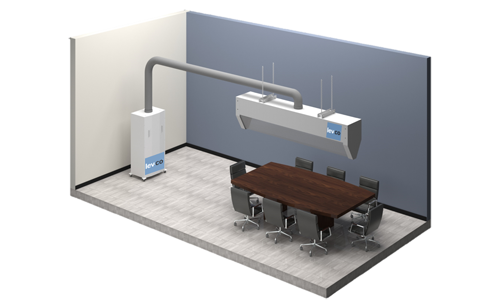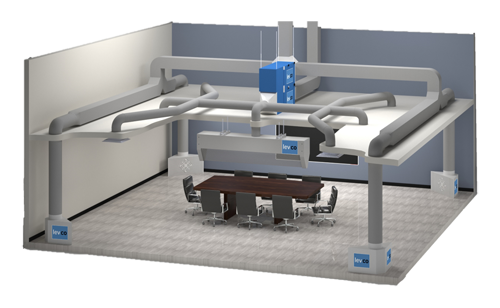
Covid-19 & Air Filtration
Everything you need to know
As the world continues to knock down the pandemic brought on by Covid-19, an infectious respiratory disease caused by a newly discovered coronavirus, new information is emerging about how it is spread.
To the concern of many, there’s increasing evidence that SARS-CoV-2, the specific coronavirus associated with the Covid-19 pandemic, can spread from person to person through the air, especially among people who occupy enclosed, crowded spaces with poor ventilation for prolonged periods.
Although it wasn’t the case when Covid-19 first emerged in early 2020, scientists and healthcare professionals worldwide now generally agree that Covid-19 can be spread through shared indoor air, particularly as more contagious variants of the coronavirus continue to be discovered.


Airborne Transmission
Among the most common factors that can contribute to the aerosol transmission of Covid-19 are activities that can cause heavy breathing, such as physical labour, singing, dancing or exercise. The risk of transmission is much greater without precautions such as wearing a mask or keeping a physical distance of at least two meters.
However, infectious disease experts now agree that airborne droplets containing the coronavirus have led to many large Covid-19 outbreaks, particularly in long-term care homes, factories and food processing plants worldwide.
Preventing the spread of Covid-19
 Most public health authorities agree that an essential part of preventing Covid-19 and other viral diseases from spreading is improving air ventilation and filtration systems in buildings. More specifically, facilities such as schools and long-term care homes, workplaces, etc.
Most public health authorities agree that an essential part of preventing Covid-19 and other viral diseases from spreading is improving air ventilation and filtration systems in buildings. More specifically, facilities such as schools and long-term care homes, workplaces, etc.
Additionally, there will be a need to improve indoor air quality in restaurants, bars, gyms, offices, factories, and other commercial and institutional buildings once they are allowed to fully open under local and regional public health orders.
The U.S. Environmental Protection Agency (EPA) now recommends improving indoor air ventilation and filtration as essential components of a larger strategy that includes social distancing, wearing face coverings or masks, surface cleaning and disinfecting and hand washing.
Can air purifiers and filters make indoor spaces safe from Covid-19?
Some air purification and filtration systems are specifically designed to filter contaminants out of the air that passes through them, including particles containing viruses. This is particularly helpful when it isn’t possible to open windows for additional ventilation because of extreme temperatures, humidity, noise and pollution or because there are simply no windows available to open.
According to the Chief Science Advisor of Canada (CSAC) Expert Panel on Covid-19, “Increasing ventilation through building controls (air changes per hour with outside air or filtered internal air) could be a method of mitigating indoor SARS-CoV-2 transmission”. CSAC adds that there is a “robust body of research related to the use of portable air filtration units to reduce disease transmission.”
Suppose you are in an indoor space that doesn’t get enough outside air for dilution. In such a case, an appropriately designed and ducted mechanical air cleaner or air purifier can make a big difference. As the CSAC has pointed out, “Many older buildings, including schools and long-term care facilities, have poorly maintained ventilation systems that would be difficult to improve in a short period.”
Which indoor air filtration systems work best against Covid-19?
To filter the coronavirus, portable HEPA filter units equipped with local control ventilation ducting are required. When properly equipped, these portable or “stand-alone” filter systems can be used to direct the virus’s path away from people seated in an enclosed area.

These filters remove microscopic particles from the air through the use of High-Efficiency Particulate Arrestors (HEPA) at a minimum specification of H14. The H14 HEPA filter is designed to filter the air of 99.995% of all particles greater than .1 Micron (100 nanometers). In other words, they are very nearly close to perfect. (Click the image on the left to watch an animated video.)
By capturing the tiny airborne particles that contain bacteria and viruses and circulating cleaned and purified air directly into the breathing zone, a well-designed air purification system can dramatically help reduce the airborne transmission of many contagious diseases, including Covid-19.
The next best solution would be an in-line retrofit solution. An in-line retrofit system is a “Clean-to-less-clean” ventilation system that uses HEPA filtration and directional airflow to move filtered air from an elevated supply through the occupants’ breathing zone and down to a floor-level return air inlet. (Click the image on the left to watch an animated video.)

From there any potentially contaminated air can be transported to a central HVAC system where it can be fan-blown through a HEPA filter and directed by automatic flow controls to ensure the HVAC system returns the required flow of clean and purified heated or cooled air.
As these airflow designs can be quite complex, it is highly advisable to conduct a Computational Fluid Dynamic simulation to allow the HVAC engineer to precisely determine the most appropriate equipment selection, design and placement of the ducted inlets and outlets.
While the EPA says many types of mechanical air cleaners can combat the airborne spread of the Covid-19 coronavirus, it correctly points out that not all air ventilation systems are equal.
Clean-to-less-clean air circulation
The EPA says the most effective air filtration and systems to guard against the airborne transmission of Covid-19 don’t simply circulate existing air around an indoor space. The air filtration system must direct the airflow in a specific pattern “so that it does not blow directly from one person to another,” thus reducing the potential spread of airborne droplets that may contain infectious viruses.
 The CDC recommends what it describes as a “clean-to-less-clean” air movement. Clean-to-less-clean ventilation takes filtered air and uses directional airflow to ensure airborne contaminants are not passed from one person to another.
The CDC recommends what it describes as a “clean-to-less-clean” air movement. Clean-to-less-clean ventilation takes filtered air and uses directional airflow to ensure airborne contaminants are not passed from one person to another.
“When used along with other best practices recommended by CDC and others,” the EPA says, “filtration can be part of a plan to reduce the potential for airborne transmission of Covid-19 indoors.”
Local Control Ventilation versus HVAC solutions
 Local control ventilation is best suited to the clean-to-less-clean method of controlling contaminated air emissions. This is due to the location of the most common emission source of the airborne virus – people’s noses and mouths.
Local control ventilation is best suited to the clean-to-less-clean method of controlling contaminated air emissions. This is due to the location of the most common emission source of the airborne virus – people’s noses and mouths.
Fortunately, our knees and feet don’t expel air, so if we can use directional airflow to move the air from elevations at the approximate height of people’s faces (while either sitting or standing) and direct the air to floor level, where it enters a return air duct, we can solve most of the problems associated with the indoor spread of the virus.
On the other hand, HVAC systems, the most common type of mechanical air ventilation method used in commercial, office and multi-residential buildings, typically only filter incoming air supply before it is widely circulated throughout a building through its ductwork.
 After that, the return air generally is filtered at a very low level of efficiency/separation, conditioned (through heating or cooling) and then returned to the enclosed indoor space to be freely mixed with any existing aerosolized virus that may be present. At that point, the virus can very easily be blown from person to person over an extended period of time.
After that, the return air generally is filtered at a very low level of efficiency/separation, conditioned (through heating or cooling) and then returned to the enclosed indoor space to be freely mixed with any existing aerosolized virus that may be present. At that point, the virus can very easily be blown from person to person over an extended period of time.
Air filter types and ratings
Some HVAC systems do employ air filtration components. Unfortunately, the filters are typically not efficient enough to capture a high degree of virus-sized particles.
Most HVAC filters adhere to the Minimum Efficiency Reporting Value (MERV). The MERV rating does not require filters to be tested for particles of less than 0.3 microns in size. While most MERV filters have a level of fractional efficiency for particles as small as the coronavirus (0.1 microns), typically, you will want to install HEPA filters with the European classification of H 14 or higher. (More info below)

What is a good ventilation rate?
According to the EPA, the greater the number of people in an indoor space, the greater the need for outdoor air ventilation. In other words, the ventilation rate should be based on the number of people that occupy an indoor space.
Question: How many air changes per hour (ACH) are necessary to ensure everyone’s health and safety in the indoor space?
Under normal circumstances, medical facilities may deploy anywhere from 15 to 25 ACH in surgical operating rooms and other areas where there’s an elevated risk of infectious disease transmission. In contrast, a corporate office HVAC system may typically only do three or four ACH, depending on the room’s size and the number of people working therein.
There are no set standards or official recommendations for the number of air changes per hour required to reduce the risk of airborne Covid-19 transmission in indoor settings.
However, local control ventilation systems can continuously distribute clean air down toward a targeted zone within a room up to 60 times an hour, creating localized pure air zones - or bubbles - around each person in the target area.

Maintenance costs
While HEPA H14 filters are significantly more expensive than lower-rated MERV filters or the sorbent filters typically used with HVAC systems, there are ways to mitigate these costs.
For example, a HEPA’s lifespan can be dramatically extended by pre-filtering the air with low-cost, high-dust loading filters of lower efficiencies. These filters are low-cost and can extend the life of your HEPA filter by months, if not years.
The pre-filter with the best ‘bang-for-the-buck’ when considering filter life, energy cost and filtration efficiency is a low-cost F5-rated filter (between a MERV 9 or 10). These filters will capture 98% of particles 5.0 micron and larger, including pollens, plant spores, hair, and visible dust. Additionally, they would filter a large amount of other dusts that would typically diminish the HEPA filter’s life.
Additional savings can be had by deploying a local HEPA H14 filtration and ventilation solution only in the indoor areas where they are needed and if they are only turned on two hours before the indoor space will be occupied by anyone.
What about when Covid-19 is eradicated and the pandemic is over?
Maintaining a clean air environment in indoor spaces promotes safety and good health at all times, regardless of the presence of Covid-19 or any other airborne contaminant, including chemicals, allergens and dust.
Research from Harvard and Syracuse Universities shows that improving the workspace’s air quality can improve worker productivity. From fewer sick days among employees to higher levels of concentration and improved performance among students, the rewards for maintaining a clean air environment are many.
